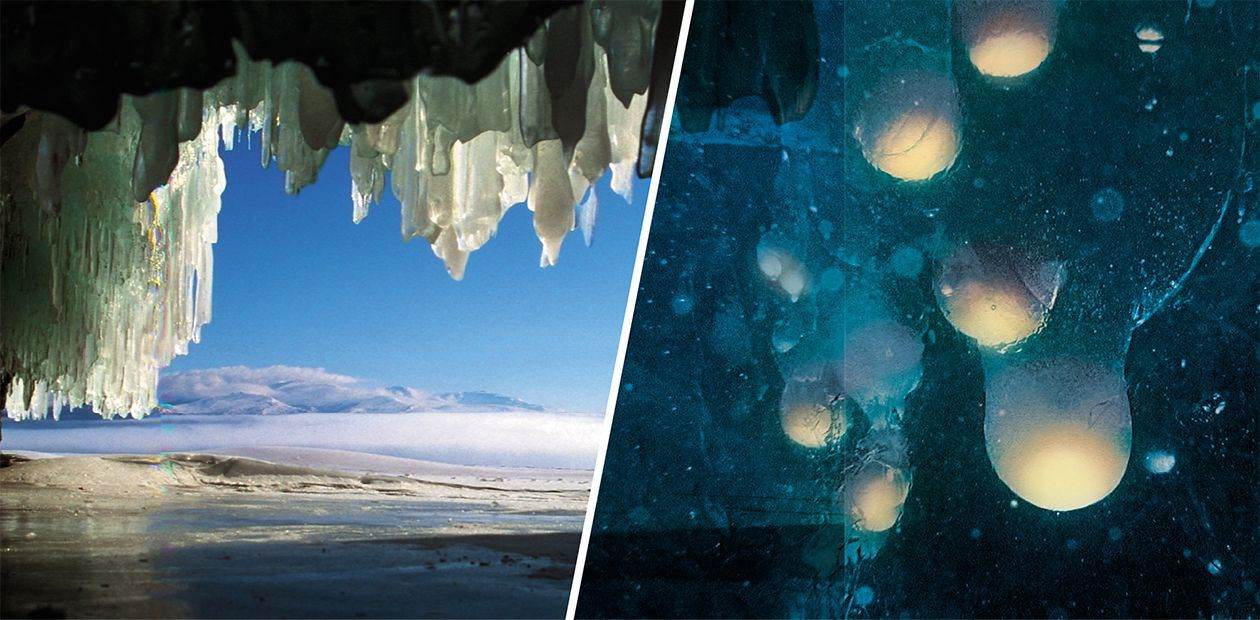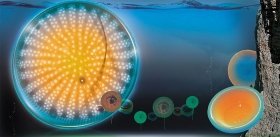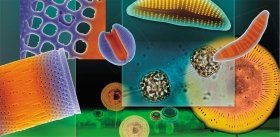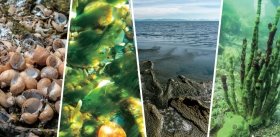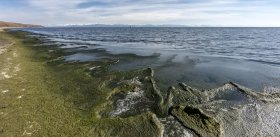Ice as the Keeper of Life
For ages man has perceived the kingdom of ice as a lifeless world, world of white muteness and thickened time. The North looks exactly as in children’s fairy-tale about Kai and Gerda. We visualize winter as the time when nature goes to sleep and plunges into dreams until spring comes. But is that really the case? Maybe a splinter of the magic glass of the Snow Queen prevents us from seeing the reality in its true light?
Until recently biological science has shown little interest in the search of life in the conditions of the cold, since it was believed vital processes occurred only at positive temperatures. At the temperature equal to 0о centigrade water freezes, therefore it was believed that no form of life could be active in the water that cold. It was supposed that the majority of these organisms either were likely to die or else fall into the state of anabiosis. However, with time evidence on the suitableness of congealed habitat for life started accumulating. The organisms could adapt to extreme conditions of existence either by using antifreezes or by staying in liquid capsules. It is astonishing, but life was discovered in the Alpine snows, Arctic and Antarctic ice caps and glaciers
The ‘Living’ Ice
The recent discoveries have given a chance to look differently at the possibilities of ice as a habitat for living organisms. It appeared that to the question “Is life in ice possible?”, the answer may be, “It is, and so turbulent at that!”
This phenomenon was first discovered in the sea ice at the end of the 19th century by the expedition headed by F. Nansen. In the summer of 1894, the famous explorer and traveler discovered clusters of algae on the edges of blocks of ice, descending into the water. By now we have learned much about the polar ‘bloody’ snow that acquires that astonishing color due to the organisms that develop in it; and also about a rich population of the sea ice of the Arctic and Antarctic Regions. At the same time it was thought for a long time that living organisms could not exist in fresh-water ice; consequently, fresh-water ice could contain only frozen-in organisms. These organisms were assumed to stay there either in the state of anabiosis or in the stage of resting (spores, cysts, and resting eggs) and to ‘revive’ only after the ice thawed. Unlike the inhabitants of the sea ice, these freshwater communities were isolated into a special class referred to as anabiocenosis.
The cause of failures in the investigation of life in freshwater ice is the following. Ice is a complex structure and consists of three phases: solid, liquid, and gaseous. The liquid phase of seawater ice is a saturated salt solution that appears at freezing of seawater. It occupies a comparatively large volume, fills a developed network of cavities and canals, and is a well-protected specific place of habitat for a living community.
In contrast to seawater ice, freshwater ice is monolithic. In its usual state its liquid phase occupies too small volume, insufficient for the development of the organisms larger than bacteria in it. Active life is practically non-existent in this monolithic (or ‘black’) ice. However, in the freshwater ice sheets, where the liquid phase takes a comparatively large volume (as, say, in the slush of snow and ice of the Alpine and Pyrenean lakes), an ice community, which includes diverse microorganisms, algae, and protozoa, has recently been discovered.
A well-developed system of pores and canals filled with melted water occurs both between the ice crystals and in the loose thawing ice. In the period of thawing of ‘black’ ice, quite an unusual biotope occurs, in which freshwater organisms can develop. Besides, in the period between intensive freezing and thawing of freshwater ice, its lower surface may get covered with algae; the phenomenon that was first discovered in the Amur River. Not long ago, we discovered cryophilic (Greek: cryo — cold, phil — loving) organisms in Baikal ice, reproducing successfully in intercrystallic water. Incidentally, before that, the ice sheet of Baikal had not attracted any close attention of researchers, since, owing to the above reasons, it was considered that life was impossible there.
The Baikal Polar Inhabitants
The major ‘polar inhabitants’ of the lake are its endemic (i.e., are found nowhere else on Earth, but here) lower plants, algae. As early as in late January, when the sun rises higher above the horizon, it slightly melts the ice around the organisms, frozen-in at the lake getting ice-bound. And the algae begin to reproduce in the formed aquatic oases. Absorbing solar energy, they are then able to ‘melt’ the ice around themselves.
In spring, when the sun is more generous in giving its warmth to the awakening nature, these impregnations of life create whimsical structures within Baikal ice. The algae inhabiting the vertical capillaries of ice, hang into the water in the form of different slimy cords and ‘beards’. Others form peculiar ‘vases’, ‘goblets’ or ‘flasks’ filled with dense slimy clusters of brownish color in the ice thickness. Ranges of various bacteria inhabit the mucus of algae. Reproducing and filling with themselves ever increasing volumes of melted water, the algae eventually permeate through the whole meter-thick ice and fall into sub-ice water to continue their development there.
The profusion of life in ice, and also immediately underneath it is quite out of the ordinary. Diverse Baikal creatures ‘are grazing’ on aggregations of algae. Business-like infusoria and Rotifera are scurrying hither and thither in these ice ‘jungles’; fry of the famous Baikal sandhopper Epischura baikalensis are crowding, and even juvenile fish and ground amphipoda find refuge and food there.
The life has not stopped in Baikal ice crumbling in the spring sun, and achieves its apogee in April through May. At that time huge long algae ‘beards’ hanging from the lower surface of ice tear off under the influence of underwater currents and their own weight. Like snowflakes, they slowly precipitate onto the bottom. The inhabitants of Baikal’s benthos are catching this windfall with open mouths. Other aggregations of algae are developing at high speed on the now vacant lower surface of ice. No less than two or three ‘crops’ of such ice ‘beds’ can precipitate in the Baikal littoral zone during one and a half to two spring months, supplying abundant food for the organisms living on the bottom. The colonies of algae in ice ‘goblets’, growing and increasing in weight, slowly descend (thaw through) to the lower surface of ice, which furthers its disintegration.
After ice has melted, all the ice organisms get into the water column, where they live thereupon for a long time and provide nurture for free-living animals. With warming of the upper layer of water the algae slowly precipitate onto the lake bottom covering it with huge slimy ‘coverlets’. In autumn the ice plant organisms return again for ‘wintering’: the annual cycle is closed and everything is repeated once again.
Who and How Lives in Ice
In different years different communities develop in the system of pores and microfissures of melting Baikal ice. Their structure depends on the composition of mass species of algae inhabiting the lake water column. By the present time we have isolated two main variants, one of which is based on endemic dinophyta algae of Gymnodinium and Peridinium genera, the other is based on endemic diatoms of the Aulacoseira genus. The total amount of cryophyllite algae inhabiting 60 to 70 cm thick ice often exceeds by two or three orders the number of the same species in sub-ice plankton. A highly nonuniform distribution of these communities in ice itself is also noteworthy.
It is curious that in pack ice, on the hummocky ice surface, in different cavities and cracks, predominantly large bottom algae rather than plankton develop. The bottom invertebrate organisms inhabit this surprising ‘forest’.
One can discover not only new species, genera and families, but even new communities of organisms!By the basic structural characteristics, the ice communities of Baikal are similar to the communities of organisms of sea ice. In both cases a marked tier structure of vertical distribution of organisms and nonuniformity of the horizontal one is observed. The same or closely related families of algae, flagellates and infusoria prevail both in sea ice and freshwater ice. The compositions of other groups of organisms that enter into the communities are also similar. Taking into account the fact that their habitats are absolutely polar, i.e., salt seawater and practically distilled thawed Baikal water, it is astonishing that the only difference between the members of the seawater and freshwater communities is the species differences.
Nevertheless, there are some principal differences between the communities. First, mention should be made of the relative brevity, ephemerality of existence of communities in freshwater ice. Secondly, in freshwater the communities inhabiting microcracks and the lower surface of ice are separated in time. Initially, when ice is still monolithic only biofouling is developing; after that, with thawing of ice, some communities emerge in the ice mass, whereas in sea ice all these communities coexist concurrently. Besides, some specific species that exist only in cryophilic communities were discovered in seawater systems. In spite of the fact that almost half of the species that inhabit Baikal ice are endemic; no other specific cryophilic species than bacteria have been discovered in Baikal.
In Icy Embrace
The main supplier or donor for ephemeral ice communities in Baikal is the lake plankton (inhabitants of its column) and benthos (bottom population). As our experiments showed, pagon, i.e., the organisms in the state of anabiosis or rest that are frozen in ice, is the main way of populating ice by interstitial communities out of the three ways, whereas for the communities of the lower portion of ice it is sub-ice water.
Colonization via the atmosphere plays an insignificant role. However, the arrival of both inorganic and organic matter with atmospheric precipitation and with the wind may greatly affect the chemical composition of the habitat, in this particular case, water from melted snow. In contrast to the seas, the ice and water from melted snow in Baikal are so weakly mineralized and have such low organic content that they are close in composition to pure distilled water. Taking this into account, the issue of sources of nutrition for such a highly populated community in such a meager habitat remains open.
An astonishingly high speed of development of ice algae and protozoa in Baikal ice communities seems incredible and inexplicable. In literature we found only one record of such a phenomenon in sea communities; it is ambiguous though. The fact of accelerated development of cryophils in Baikal does not give rise to doubts, since the daily growth of ice algae colonies could be measured almost in centimeters. All this occurs in the conditions of almost total ‘absense’ of nutritive material and the temperature near or equal to zero. Could the so-called “phenomenon of water from melted snow” manifest itself here? Or could some regulatory mechanisms (cellular or population) be to set going in these ephemeral communities, similar to what happens in deserts in the raining season or during a brief arctic summer?
Finding of turbulent life in the ice cover of Baikal, which was concealed before, posed a number of questions not only to biologists. What are the physical and chemical distinctive characteristics of fresh-water ice habitat, which at first sight is devoid of nutritive material necessary for supporting life? And why is capillary water particularly attractive for the organisms? And finally, how can one study biological processes in this habitat?
There are no exhaustive answers to these questions yet. But the problem is in itself so challenging and promising that it requires an attraction of a wide range of specialists of every description, physicists, cytologists, physiologists, and medical men.
An important discovery has lately been made in the far Antarctica. A four-kilometer deep borehole was driven in the ice cover under the Russian station “Vostok”. Living microorganisms were found in the cores of ice that was millions of years of age. How could they have retained their viability in such conditions and for such a long time?
Ice keeps a lot more mysteries. But man managed to solve one of those mysteries, the most important, that is, that ice is not the dead, lifeless kingdom of the cruel Snow Queen; on the contrary, it is a treasury of biodiversity, solicitous Keeper of life that flourishes in his warm embrace…
Photos by O. A. Timoshkin


